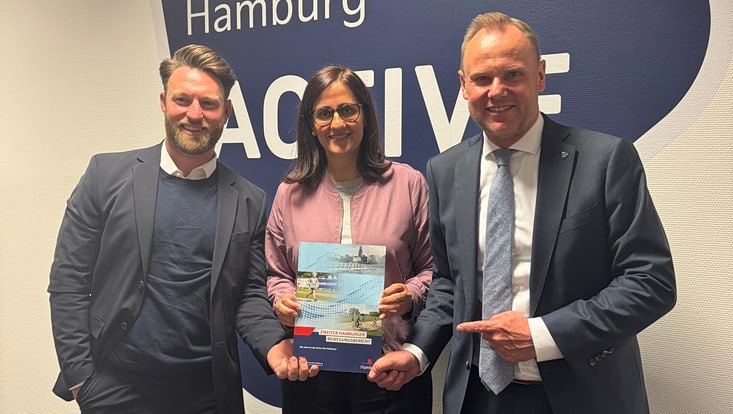Center a pioneer in movement research“We are assuming a central coordinating role in the long term.”
23 June 2025, by Anna Priebe

Photo: Mona Herden
For over 5 years, a team from the Institute of Human Movement Science has been looking at how active Hamburg is. The project led to the founding of Science and Transfer Center Active City. In the interview below, the center’s head, Dr. Nils Schumacher, talks about their work, which was also introduced at the Sports, Medicine and Health Summit.
You have been with the Active City Hamburg project for several years. What are you researching?
We are looking at the question, both from a scientific point of view and practically, as to how physical activity in urban spaces, for example in Hamburg, can be increased to improve health? This means we look at how people move in different age and target groups and develop practical recommendations for policymakers and other societal actors, such as schools and companies.
We are using large-scale epidemiological studies such as the Hamburg City Health Study or the national health study. Surveys on matters such as school entryways also provide important information about children’s movement behaviors. For our studies, we work closely with very different institutions and organizations, for example, the University Medical Center Hamburg-Eppendorf.
Activities are consolidated at the Science and Transfer Center Active City. What does this institution do?
Science and Transfer Center Active City is a joint institution of the City of Hamburg and the University of Hamburg. It started as a single research project and became an ongoing, institutionalized venture. The STC will take a central coordinating role in the long term and is creating sustainable structures for the systematic collection, use, and provision of data.
Our goal is long-term monitoring of movement behaviors, and not just for 2 or 5 but for 10 or more years. This will allow us to make trends visible and to analyze developments over longer periods. A second, short-term goal is ongoing screening, meaning identifying concrete needs at an early stage. For example, we can see in which neighborhoods children seldom learn to swim and respond directly.
One result of your work is the Hamburg movement report, of which the second issue has just been published. To what extent do such projects benefit from new structures?
The movement report that we initiated is unique in Germany and we see it as a core activity of the STC Active City. Based on analyses, we were able to determine, for example, that the share of children who can swim varies greatly in Hamburg’s neighborhoods, and social standing seems to have a large impact on this. Our report provide concrete starting points for political measures, but also for schools, clubs, and doctor’s practices. By institutionalizing the center, we can monitor and evaluate the measures in the long term.
Our first project is the development of a “movement primer” that we want to distribute to pediatricians and parents so that they are familiar with early childhood swimming abilities and generally with fostering movement and to offer concrete tips. We are providing scientific guidance from the initial to the implementation phase to understand how movement advice, in this case in doctor’s offices, can succeed. We can use these findings for other regions and cities.
You present your research findings and experience at the Sports, Medicine and Health Summit, which you help to organize as the managing director. Why are these kinds of events so important for science?
Scientific findings in applied fields such as sports science and sports medicine should be flow into daily life as quickly as possible. The Sports, Medicine and Health Summit should not, therefore, be just a scientific congress but provide current research findings for practitioners. In other words: knowledge exchange.
For example, we address pediatricians and discuss how evidence-based movement recommendations need to be handled in doctors’ offices. But there are also teachers and 200 schoolchildren, sports club reps, and physiotherapists on site.
At the same time, as part of the Global Alliance Day, international reps from prestigious organizations in sports, academia, and politics meet to discuss global measures and policies to foster movement and health worldwide.
Can the STC be a role model for Germany?
After we look at the data on Hamburg’s movement habits, we want to look at the findings in a national comparison. A few surveys are also being conducted in this way in other German states and cities, but there are no data for many questions. This is why we are definitely of the opinion that there need to be more of these kinds of institutions.
Sports, Medicine and Health Summit conference
The summit is taking place from 26 to 28 June 2025 and targets experts in sports, medicine, and health. The Hamburg Ministry of the Interior and Sports is funding the conference. The University of Hamburg is a cooperation partner. Dr. Nils Schumacher, Dr. Christine Busch, Prof. Dr. Rüdiger Reer, Dr. Christian Spreckels, Prof. Dr. Astrid Zech, Prof. Dr. Wanja Wolf, Prof. Dr. Erin Gerlach, Prof. Dr. Klaus-Michael Braumann, and further researchers from the University of Hamburg are designing the program. More details on the program and on registration are available on the conference website


